Childhood Maltreatment and Psychiatric Disorders Among Detained Youths
Abstract
Objective:
This study examined the prevalence of childhood maltreatment and its relationship with current psychiatric disorders among detained youths.
Methods:
Clinical research interviewers assessed history of childhood maltreatment with the Child Maltreatment Assessment Profile and psychiatric diagnosis with the Diagnostic Interview Schedule for Children, version 2.3, in a stratified, random sample of 1,829 youths detained at the Cook Country Juvenile Temporary Detention Center (final sample, N=1,735). History of maltreatment was also ascertained from Cook County Court Child Protection Division records.
Results:
More than three-quarters of females and more than two-thirds of males had a history of physical abuse (moderate or severe). More than 40% of females and 10% of males had a history of sexual abuse. Females and non-Hispanic whites had the highest prevalence rates of childhood maltreatment. Among females, sexual abuse was associated with every type of psychiatric disorder. Females who experienced various types of abuse were 2.6 to 10.7 times as likely as females with no maltreatment to have any disorder. Among males, maltreatment was associated with every disorder except anxiety disorders (range of odds ratios, 1.9–7.9). Among youths who were sexually abused, abuse with force was associated with anxiety and affective disorders among females and attention-deficit hyperactivity or disruptive behavior disorders and substance use disorders among males.
Conclusions:
Childhood maltreatment is common among detained youths and is also highly associated with psychiatric disorders. The mental health, child welfare, and juvenile justice systems must collaborate to ensure that youths receive protection and care when they return to their communities. (Psychiatric Services 62:1430–1438, 2011)
Many youths detained by the juvenile justice system have been victims of childhood maltreatment and have psychiatric disorders. Depending on the sample and measure, 3% to 53% of detained youths have a history of sexual abuse (1–6) and 27% to 75% have a history of physical abuse (1,3,7,8). Recent studies have also found that over two-thirds of detained youths have a psychiatric disorder (9,10).
Studies of community, homeless, and clinical samples have documented an association between maltreatment and psychiatric disorders (11–18). Despite the high prevalence of maltreatment and psychiatric disorders among detained youths, few studies have examined the association between them in this population. Instead, most studies have focused on childhood maltreatment and its association with drug use (5,19–22). We found only three studies of childhood maltreatment and psychiatric disorders among detained youths (4,7,23). All three reported an association between maltreatment and disorders. Yet, these studies focused on only one or two disorders and had methodological limitations.
Dixon and colleagues (23) examined posttraumatic stress disorder (PTSD) and childhood sexual abuse among female juvenile detainees in Australia. However, their sample was small (N=100), and the results are of limited generalizability to youths detained in the United States. They also relied on only one screening question to assess sexual abuse. Using one question may result in underreporting; a more reliable and robust approach is to ask a series of specific questions about types of sexual abuse (24). Two studies of detainees conducted in the United States (4,7) had large samples (N>500) but also used only one screening question to assess maltreatment. Gover and MacKenzie (7) examined the association between childhood maltreatment and depression and anxiety; however, they combined all types of maltreatment for analyses (7). Gover (4) focused only on the relationship between childhood sexual abuse and depression (4).
To our knowledge, no large-scale study of detained youths has examined the relationship between childhood maltreatment and a range of psychiatric disorders. This omission is critical because findings from studies of community, homeless, and clinical samples (11–18) may not generalize to detained youths, who are disproportionately poor and male and from racial-ethnic minority groups. Furthermore, the detention center is a potential point of triage for child protection services and psychiatric treatment. Data on the association between child maltreatment and psychiatric disorders will help guide effective protective and therapeutic interventions.
This is the third article to report data on childhood maltreatment among participants in the Northwestern Juvenile Project, a longitudinal study of health needs and outcomes of detained youths. The first report documented the low concordance rates between self-reports and official records of physical abuse; only 17% of those who reported physical abuse had a court record of maltreatment (25). The second study examined forced sexual victimization as part of a larger study of PTSD and trauma; however, it did not examine physical abuse (26).
In this article, we present prevalence data on physical and sexual abuse, assessed by self-report and official records. We then present findings on the relationship between types of maltreatment and four types of psychiatric disorders: anxiety, affective, disruptive behavior, and substance use. We hypothesized that all types of maltreatment would be associated with psychiatric disorders, that youths with a history of severe maltreatment would have the highest prevalence rates of disorders, and that patterns of associations between maltreatment and psychiatric disorders would differ for males and females.
Methods
Sampling procedures
Participants were 1,829 male and female youths, randomly sampled at intake into the Cook County Juvenile Temporary Detention Center (CCJTDC) from November 1995 through June 1998 (27). The sample was stratified by gender, race-ethnicity (African American, non-Hispanic white, and Hispanic), age (ten to 13 years or 14 years and older), and legal status (processed in juvenile or adult criminal court). Within each stratum, we used a random-numbers table to select names from the CCJTDC intake log. Selected demographic strata (for example, females, non-Hispanic whites, and ten- to 13-year-olds) were oversampled to obtain adequate numbers of participants in key subgroups. The final sampling fractions ranged from .018 to .689. Additional information on the sample is available from the authors.
Interviewers described the study to participants and obtained written informed assent (if participants were less than 18 years old) or consent (if they were age 18 or older). The Northwestern University Institutional Review Board, the Centers for Disease Control and Prevention Institutional Review Board, and the U.S. Office of Protection from Research Risks all approved the study and waived parental consent, consistent with federal regulations regarding research with minimal risk. We nevertheless tried to contact parents or guardians to inform them and offer them an opportunity to decline participation. Despite repeated attempts to contact a parent or guardian, none could be found for 44% of the participants. In lieu of parental consent, an independent participant advocate representing the interests of the participants oversaw youths' assent. Federal regulations allow for a participant advocate if parental consent is not feasible.
Participants were interviewed in a private area, almost always within two days of intake; most interviews lasted between two and three hours. Interviewers were trained for a month. Most had a master's degree in the social sciences and experience interviewing high-risk youths; one-third were fluent in Spanish. Female interviewers always interviewed females. Additional information on the study's methods has been reported elsewhere (27).
The rigors of the detention center's schedule required approximately 5% of the interviews to end prematurely. Because childhood maltreatment was assessed at the end of the interview, these data were missing for 94 participants. The final sample for this analysis (N=1,735) consisted of 1,095 males and 640 females. The sample included 957 African Americans, 287 non-Hispanic whites, 488 Hispanics, and three youths who identified as “other” race-ethnicity. The childhood maltreatment module was more likely to be received by females than by males (N=640, 97%, versus N=1,095, 93%, p<.05) and by non-Hispanic whites than by Hispanics (N=287, 97%, versus N=488, 93%, p<.05). We accounted for potential bias from demographic differences in missing data by weighting the data. The mean age of the 1,735 participants was 14.8±1.4 years (range of ten to 18 years), and the median age was 15 years.
Measures
Self-report of childhood maltreatment.
Interviewers administered the Child Maltreatment Assessment Profile (CMAP), a structured interview based on the Child Maltreatment Interview (24) and the Child Abuse Module for the National Institute of Mental Health's Methods for the Epidemiology of Child and Adolescent Mental Disorders Study (28). The CMAP assesses six types of sexual victimization, use of force, and relationship to the perpetrator. There is no screening question. Instead, participants are asked about each type of abuse by each type of perpetrator.
To assess physical abuse, participants were asked how many times they had ever experienced each of five types of corporal punishment by “an adult or person who was in charge” of them. We classified experiences of being “hurt by an adult that resulted in bruises, broken bones, or severe injury” as severe physical abuse. We classified being “hit very hard,” “hit with an object,” or “beaten or kicked” as moderate physical abuse.
Official records of childhood maltreatment.
Project staff searched current and past records from the Cook County Court Child Protection Division for participants' names. These records consist of abuse and neglect petitions that were filed with the court after investigation by the Illinois Department of Children and Family Services (DCFS). Participants who were found by DCFS to have “credible evidence” of physical or sexual maltreatment were considered to have been abused. Petitions for “Excessive Corporal Punishment” and for “Substantial Risk of Physical Injury” were classified as severe physical abuse.
Rates of severe physical abuse and any sexual abuse are based on self-reported data or data from the court records; moderate physical abuse and specific types of sexual abuse are based on self-reported data only.
To analyze the relationship between a history of maltreatment and having a psychiatric disorder, we created an independent variable with five mutually exclusive categories of maltreatment: none, moderate physical abuse only, severe physical abuse, sexual abuse, and sexual and severe physical abuse. Participants classified in one of the latter three categories may have also experienced moderate physical abuse.
Psychiatric disorders.
We used the Diagnostic Interview Schedule for Children (DISC), version 2.3 (29), the most recent version available at the time of data collection. The DISC 2.3, which is based on the DSM-III-R, assesses the presence of psychiatric disorders in the past six months. It is highly structured, contains detailed symptom probes, has acceptable reliability and validity, and requires relatively brief training. Data are based on youths' self-report because it was not feasible to interview caretakers.
We began collecting data on PTSD 13 months after the larger study began, when the DISC version IV (DISC-IV) module became available for use; data on PTSD were collected for 898 participants. Of these, three did not receive the CMAP; therefore, PTSD was measured for 895 participants in the sample of 1,735 participants (531 males and 364 females).
For our analyses, we examined four types of disorder: any anxiety disorder (generalized anxiety disorder, overanxious disorder, panic disorder, obsessive-compulsive disorder, separation anxiety disorder, or PTSD), any affective disorder (major depressive episode, manic episode, hypomania, or dysthymic disorder), any attention-deficit hyperactivity disorder (ADHD) or disruptive behavior disorder (conduct disorder or oppositional defiant disorder), and any substance use disorder (abuse of or dependence on alcohol, marijuana, or other substances).
Statistical analysis
All analyses were conducted by using the survey routines in Stata SE, version 11.0 (30,31). To generate descriptive statistics and model parameters that reflect CCJTDC's population, each participant was assigned a sampling weight augmented with a nonresponse adjustment to account for demographic differences in missing data (32). We used logistic regression to compare rates of abuse by demographic characteristics and to compare rates of psychiatric disorders by history of maltreatment. Taylor series linearization was used to estimate model variances. We tested for differences between specific groups (for example, African American youths compared with Hispanic youths) when the overall categorical predictor (in this example, race-ethnicity) was significant at the p<.05 level. Only statistically significant findings (p<.05) are noted in the text and tables.
Results
Prevalence rates of maltreatment
Tables 1 and 2 present prevalence rates of maltreatment among females (Table 1) and males (Table 2) by racial-ethnic group and odds ratios (ORs) comparing the groups.
Physical abuse.
More than three-quarters of females and more than two-thirds of males had experienced some type of physical abuse (moderate or severe) (the combined rates are not shown in the tables). More than one-third of females and 15% of males had a history of severe physical abuse. Prevalence rates of physical abuse from official records were low; 3% of females and 1% of males had court records of physical abuse (data not shown). Females had significantly higher rates than males for every type of physical abuse and were three times as likely to have been severely physically abused (OR=3.0, 95% CI 2.1–4.3; Table 2). Among females, non-Hispanic whites and Hispanics had higher rates than African Americans of severe physical abuse and of being beaten or kicked. Non-Hispanic white males also had higher rates of several types of abuse than African American or Hispanic males, including severe physical abuse.
Sexual abuse.
Forty-one percent of females and 11% of males experienced sexual abuse. Prevalence rates of sexual abuse from official records were low: 1% of females and .1% of males had court records of sexual abuse (data not shown). Compared with males, females had nearly six times the odds of any sexual abuse and were four to seven times more likely to have experienced each type of sexual abuse (ORs in Table 2). Among females, non-Hispanic whites were more likely to have been victims of sexual abuse than African-American or Hispanic females.
Twenty-one percent of females and 4% of males had experienced sexual and severe physical abuse. Females had more than six times the odds of experiencing both sexual and severe physical abuse compared with males.
Childhood maltreatment and psychiatric disorders
Tables 3 and 4 present prevalence rates and odds ratios describing the association between maltreatment and psychiatric disorders for females (Table 3) and males (Table 4). Compared with females who had no childhood maltreatment, females who had been victims of moderate physical abuse (only) were more than twice as likely to have anxiety and substance use disorders; females who had been victims of severe physical abuse were more likely to have ADHD or disruptive behavior disorders and substance use disorders. Females who had been victims of sexual abuse or victims of both sexual and severe physical abuse were more than twice as likely to have every type of disorder examined.
Compared with males who had no childhood maltreatment, males who had been victims of moderate physical abuse (only), severe physical abuse, or sexual abuse were significantly more likely to have all disorders examined except anxiety disorder. The prevalence of ADHD or disruptive behavior disorders was higher among males who experienced sexual and severe physical abuse than among those who had no maltreatment. The small number of males who experienced both sexual and severe physical abuse (N=37) may have limited our power to detect differences as statistically significant.
Sexual abuse with force and psychiatric disorders
Among participants who self-reported sexual abuse, 63% of females and 22% of males reported being abused with force. As shown in Table 5, more than 90% of all youths who reported sexual abuse with force had a psychiatric disorder. Females who were abused with force had significantly higher rates of anxiety and affective disorders than females who were abused without force. Relatively few males reported sexual abuse with force (N=22); however, males abused with force had significantly higher rates of ADHD or disruptive behavior disorders and substance use disorders than those abused without force.
Discussion
The results indicate that detained youths who experienced childhood maltreatment had higher rates of psychiatric disorders than those who had not been maltreated. Nearly every type of maltreatment and combination of types was associated with increased odds of having one or more of the psychiatric disorders assessed. Prevalence rates of disorders were especially high among participants who experienced sexual abuse; nearly all youths who were sexually abused with force had a psychiatric disorder. Consistent with other studies of sexually abused children (33–36), our findings show that severity of sexual abuse may increase the odds of having a psychiatric disorder.
These findings are particularly important given the high prevalence rates of maltreatment in our sample and in prior studies of juvenile detainees (2,20). The prevalence of maltreatment among detained youths far exceeds the prevalence of maltreatment among youths in the general population (15,18). For example, a telephone survey of adolescents in the general population found that 13% of females and 3% of males reported a history of sexual abuse, compared with 41% of females and 11% of males in this study of detainees (15,18). The discrepancy is even greater for physical abuse: in the general population survey, 10% of females and 9% of males reported a history of physically abusive punishment, compared with 76% of female detainees and 68% of male detainees in this study (15,18).
As in a prior study of delinquent youths (21), we found higher rates of maltreatment among non-Hispanic white detainees, especially among females. This finding differs from general population studies, which have found similar or higher rates of maltreatment among youths from racial-ethnic minority groups (37). Our findings may reflect underlying racial-ethnic disparities in the juvenile justice system and the different pathways by which non-Hispanic whites and youths from racial-ethnic minority groups enter the system (38,39). For example, non-Hispanic whites, who typically have greater access to services than youths from minority groups (40), may be less likely to be arrested. Thus non-Hispanic whites who are arrested may have more psychosocial problems, including maltreatment, than youths from minority groups who are arrested.
Prior studies of general population samples have not found consistent gender differences in the associations between types of maltreatment and types of psychiatric disorder (33,41). As in previous studies of youths who had been abused (33,41), in our study both male and female detainees who reported sexual abuse had high rates of most disorders. Our findings suggest, however, that sexual abuse with force is associated with ADHD or disruptive behavior disorders and substance use disorders among males and anxiety and affective disorders among females. We also found that among females, severe physical abuse alone was associated with ADHD or disruptive behavior disorders and substance use disorders; in contrast, among males, physical abuse was associated with affective disorders. Our data provide some support for the theory that males and females may have different vulnerability to internalizing and externalizing disorders, at least for certain types of maltreatment (33,41).
This study had some limitations. The findings were drawn from a single site and may not be generalizable to youths in other detention centers, especially those with different demographic characteristics. Data are subject to the limitations of self-report and official records. Participants were sampled between 1995 and 1998; findings may differ for youths currently in detention. Adolescents may underreport painful experiences, and official records underestimate actual maltreatment (42,43).
Statistical power may have been too low to detect some differences. For example, the small number of males who reported sexual abuse may have limited our ability to detect an association between sexual abuse with force and the presence of a psychiatric disorder. Some participants may have tended to endorse positive responses, artificially inflating the association between abuse and disorders. Findings may have differed slightly if a later version of the DISC, based on DSM-IV criteria, were available. Despite these limitations, the study has implications for treatment, public policy, and research on delinquent youths.
Conclusions
Investigate gender differences
Future studies need to investigate whether the relationship between maltreatment and psychiatric disorders is mediated by factors that affect males and females differently. For example, Meyerson and colleagues (33) studied two dimensions of family environment—conflict and cohesion—among maltreated youths. They found that lack of family cohesion was associated with depression among males who had been maltreated; however, family conflict was a better predictor of depression for females who had been maltreated (33). Identifying mediators that account for gender differences will help to improve gender-specific prevention and treatment models for victims of maltreatment.
Study resiliency in youths at risk
Not all victims of maltreatment develop psychiatric disorders or become delinquent. Future studies need to investigate characteristics that promote resiliency among youths already at risk. Studies should focus on characteristics that can be altered and examine when protective factors have the most impact.
Identify youths at risk
Our findings highlight the importance of assessing the presence and severity of physical and sexual abuse when conducting routine mental health evaluations in detention settings. Referral and treatment could reduce the youths' risk of revictimization, psychiatric disorders, criminal recidivism, and associated consequences (44,45).
Focus on rehabilitation
Rather than adopting the more punitive stance of the adult justice system, the juvenile justice system should continue to focus on the mission of rehabilitation, particularly for youths with histories of abuse. One innovative strategy, adopted by several states and other jurisdictions in the past decade (for example, New York City, Illinois, and Los Angeles County), is to integrate the juvenile justice and child welfare systems (46,47). Practical and philosophical barriers notwithstanding (46), integration of these systems, as well as close collaboration with mental health services, promotes the decriminalization of many delinquent behaviors, prevents unnecessary institutionalization, and provides avenues for delinquent youths to receive necessary protective services and therapeutic services (48).
In conclusion, this study adds to a body of literature demonstrating that a substantial proportion of youths in detention have been or are being maltreated. Maltreatment has consequences. Depending on the type of maltreatment, between 65% and 95% of youths who had been maltreated had at least one psychiatric disorder. The mental health, child welfare, and juvenile justice systems must collaborate to ensure that these youths receive the protection and care they need when they return to their communities.
1 : The relationship between traumatic exposure, family dysfunction, and post-traumatic stress symptoms in male juvenile offenders. Journal of Traumatic Stress 7:83–93, 1994 Crossref, Medline, Google Scholar
2 : Trauma, drugs and violence among juvenile offenders. Journal of Psychoactive Drugs 32:43–54, 2000 Crossref, Medline, Google Scholar
3 : Sexual and physical abuse among incarcerated youth: implications for sexual behavior, contraceptive use, and teenage pregnancy. Child Abuse and Neglect 22:987–995, 1998 Crossref, Medline, Google Scholar
4 : Childhood sexual abuse, gender, and depression among incarcerated youth. International Journal of Offender Therapy and Comparative Criminology 48:683–696, 2004 Crossref, Medline, Google Scholar
5 : The relationship between physical and sexual abuse and illicit drug use: a replication among a new sample of youths entering a juvenile detention center. International Journal of the Addictions 23:1101–1123, 1988 Crossref, Medline, Google Scholar
6 : An inquiry into the problem of child abuse and juvenile delinquency; in Exploring the Relationship Between Child Abuse and Delinquency. Edited by Hunner RJWalker YE. Montclair, NJ, Allanheld, Osmun, 1981 Google Scholar
7 : Child maltreatment and adjustment to juvenile correctional institutions. Criminal Justice and Behavior 30:374–396 2003 Crossref, Google Scholar
8 : The relationship of victimization through child abuse to aggressive delinquent behavior. Victimology 7:199–203, 1982 Google Scholar
9 : Mental disorders among adolescents in juvenile detention and correctional facilities: a systematic review and metaregression analysis of 25 Surveys. Journal of the American Academy of Child and Adolescent Psychiatry 47:1010–1019, 2008 Medline, Google Scholar
10 : Detecting mental disorder in juvenile detainees: who receives services? American Journal of Public Health 95:1773–1780, 2005 Crossref, Medline, Google Scholar
11 : Mental health in pediatric settings: distribution of disorders and factors related to service use. Journal of the American Academy of Child and Adolescent Psychiatry 39:841–849, 2000 Crossref, Medline, Google Scholar
12 : The characteristics and mental health of homeless adolescents: age and gender differences. Journal of Emotional and Behavioral Disorders 8:230–239, 2000 Crossref, Google Scholar
13 : Traumas and other adverse life events in adolescents with alcohol abuse and dependence. Journal of the American Academy of Child and Adolescent Psychiatry 36:1744–1751, 1997 Crossref, Medline, Google Scholar
14 : Impact of sexual abuse on children: a review and synthesis of recent empirical studies. Psychological Bulletin 113:164–180, 1993 Crossref, Medline, Google Scholar
15 : Prevalence and Consequences of Child Victimization. Washington DC, National Institute of Justice, US Department of Justice, 1997 Google Scholar
16 : Major depression in individuals with a history of childhood physical or sexual abuse: relationship to neurovegetative features, mania, and gender. American Journal of Psychiatry 155:1746–1752, 1998 Link, Google Scholar
17 : Childhood abuse and lifetime psychopathology in a community sample. American Journal of Psychiatry 158:1878–1883, 2001 Link, Google Scholar
18 : The long-term sequelae of child and adolescent abuse: a longitudinal community study. Child Abuse and Neglect 20:709–723, 1996 Crossref, Medline, Google Scholar
19 : The relationship between physical and sexual abuse and tobacco, alcohol, and illicit drug use among youths in a juvenile detention center. International Journal of the Addictions 23:351–378, 1988 Crossref, Medline, Google Scholar
20 : Physical abuse, sexual victimization and illicit drug use: a structural analysis among high-risk adolescents. Journal of Adolescence 10:13–33, 1987 Crossref, Medline, Google Scholar
21 : Physical abuse, sexual victimization, and illicit drug use: replication of a structural analysis among a new sample of high-risk youths. Violence and Victims 4:121–138, 1989 Crossref, Medline, Google Scholar
22 : Further examination of the association between heavy marijuana use and crime among youths entering a juvenile detention center. Journal of Psychoactive Drugs 19:361–373, 1987 Crossref, Medline, Google Scholar
23 : Trauma exposure, posttraumatic stress, and psychiatric comorbidity in female juvenile offenders. Journal of the American Academy of Child and Adolescent Psychiatry 44:798–806, 2005 Crossref, Medline, Google Scholar
24 : Child Abuse Trauma: Theory and Treatment of the Lasting Effects. Newbury Park, Calif, Sage, 1992 Google Scholar
25 : Concordance between self-reported maltreatment and court records of abuse or neglect among high-risk youths. American Journal of Public Health 96:1849–1853, 2006 Crossref, Medline, Google Scholar
26 : Posttraumatic stress disorder and trauma in youth in juvenile detention. Archives of General Psychiatry 61:403–410, 2004 Crossref, Medline, Google Scholar
27 : Psychiatric disorders in youth in juvenile detention. Archives of General Psychiatry 59:1133–1143, 2002 Crossref, Medline, Google Scholar
28 : Child Abuse Module of Columbia University Noncore SURF. New York, NY, New York State Psychiatric Institute, 1991 Google Scholar
29 : The NIMH Diagnostic Interview Schedule for Children Version 2.3 (DISC-2.3): description, acceptability, prevalence rates, and performance in the MECA study. Journal of the American Academy of Child and Adolescent Psychiatry 35:865–877, 1996 Crossref, Medline, Google Scholar
30 : Sampling Techniques. New York, Wiley, 1977 Google Scholar
31 Stata Statistical Software: Release 11. College Station, Tex, Stata Corp, 2009 Google Scholar
32 : Analysis of Health Surveys. New York, Wiley, 1999 Crossref, Google Scholar
33 : The influence of childhood sexual abuse, physical abuse, family environment, and gender on the psychological adjustment of adolescents. Child Abuse and Neglect 26:387–405, 2002 Crossref, Medline, Google Scholar
34 : The relationship of abuse characteristics to symptoms in sexually abused girls. Journal of Interpersonal Violence 10:259–274, 1995 Crossref, Google Scholar
35 : A review of the short-term effects of child sexual abuse. Child Abuse and Neglect 15:537–556, 1991 Crossref, Medline, Google Scholar
36 : A review of the long-term effects of child sexual abuse. Child Abuse and Neglect 16:101–118, 1992 Crossref, Medline, Google Scholar
37 : Child maltreatment in the United States: prevalence, risk factors, and adolescent health consequences. Pediatrics 118:933–942, 2006 Crossref, Medline, Google Scholar
38 Easy Access to Juvenile Court Statistics: 1985–2007. Washington, DC, US Department of Justice, Office of Justice Programs, Office of Juvenile Justice and Delinquency Prevention, 2010. Available at www.ojjdp.gov/ojstatbb /ezajcs Google Scholar
39 Easy Access to the Census of Juveniles in Residential Placement. Washington, DC, US Department of Justice, Office of Justice Programs, Office of Juvenile Justice and Delinquency Prevention, 2008. Available at www.ojjdp.gov/ojstat bb/ezacjrp/ Google Scholar
40 Mental Health: Culture, Race, and Ethnicity: A Supplement to Mental Health: A Report of the Surgeon General. Rockville, Md, US Department of Health and Human Services, US Public Health Service, 1999 Google Scholar
41 : Social and emotional outcomes of childhood sexual abuse a review of recent research. Aggression and Violent Behavior 7:567–589, 2002 Crossref, Google Scholar
42 : Juvenile Offenders and Victims: 2006 National Report. Washington, DC, US Department of Justice, Office of Justice Programs, Office of Juvenile Justice and Delinquency Prevention, 2006 Google Scholar
43 : Characteristics of crimes against juveniles. Juvenile Justice Bulletin, June 2000. Available at www.ncjrs.gov/pdffiles1/ojjdp/179034.pdf Google Scholar
44 : Childhood victimization, running away, and delinquency. Journal of Research in Crime and Delinquency 36:347–370, 1999 Crossref, Google Scholar
45 : The impact of childhood sexual abuse on later sexual victimization among runaway youth Journal of Research on Adolescence 11:151–176, 2001 Crossref, Google Scholar
46 : Child Welfare and Juvenile Justice Systems Integration Initiative: A Promising Progress Report. Arlington, Va, Child Welfare League of America, 2008 Google Scholar
47 : When Systems Collide: Improving Court Practices and Programs in Dual Jurisdiction Cases. Pittsburgh, Pa, National Center for Juvenile Justice, 2004 Google Scholar
48 Governor David Paterson's Task Force on Transforming Juvenile Justice: Charting a New Course: A Blueprint for Transforming Juvenile Justice in New York State. New York, Vera Institute of Justice, 2009 Google Scholar
Figures and Tables
Table 1 Prevalence rates of childhood maltreatment among 640 female juvenile detainees, by racial-ethnic group
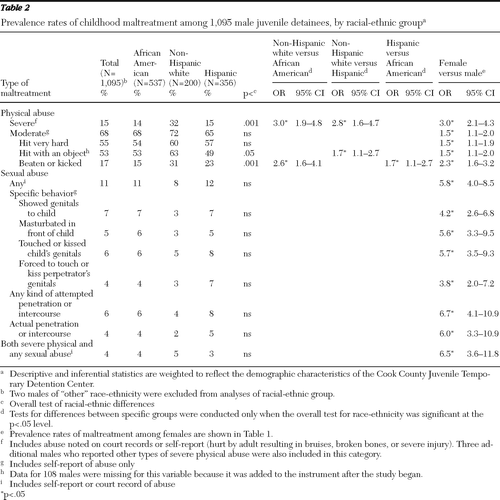
Table 2 Prevalence rates of childhood maltreatment among 1,095 male juvenile detainees, by racial-ethnic group
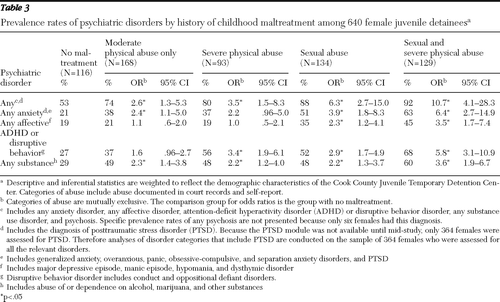
Table 3 Prevalence rates of psychiatric disorders by history of childhood maltreatment among 640 female juvenile detainees
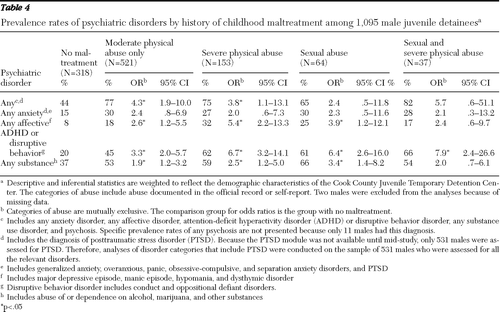
Table 4 Prevalence rates of psychiatric disorders by history of childhood maltreatment among 1,095 male juvenile detainees
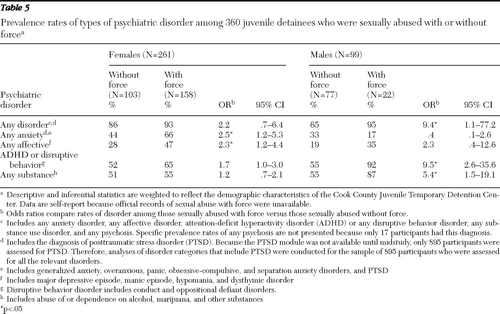
Table 5 Prevalence rates of types of psychiatric disorder among 360 juvenile detainees who were sexually abused with or without force



